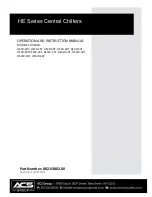
Blue Box - 17
MECHANICAL HAZARDS
Operating mode
Analysed risk or hazard
Solution adopted
Normal operating regime
Maintenance
Stability
Because of their intrinsic characteristics, the
units are not associated with problems of
possible falling or tipping while in operation.
However, you must carefully read the
descriptions given in this manual concerning
the methods of positioning the unit.
Handling during transport
and installation.
Stability
The unit's base frame has specific lifting
holes, the positions of which are marked
with yellow decals, designed to eliminate the
risk of the unit tipping.
Normal Operating regime
Maintenance
Pipe bursts.
The pipes are rigidly anchored to reduce
vibration, a major cause of pipe fracture.
Normal Operating regime
Surfaces, sharp corners and
edges.
The machine is designed and manufactured
to minimise the presence of sharp corners
and edges as far as possible. If the unit is
located in areas easily accessible by non
qualified people provide suitable protection.
Maintenance
Surfaces, sharp corners edges. In the interior parts of the unit it is not
possible to completely eliminate risks derived
from the presence of surfaces, sharp corners
and edges. For this reason the user,
installation, and maintenance manual
specifies that maintenance operations be
carried out exclusively by qualified personnel,
simultaneously providing indications on the
protection to be utilised.
Normal Operating regime
Cutting or severing.
The inside part of the unit does not have
moving parts
Maintenance
Cutting or severing.
The inside part of the unit does not have
moving parts
Normal operating regime
Entanglement, dragging,
impact.
The inside part of the unit does not have
moving parts
Maintenance
Entanglement, dragging,
impact.
The inside part of the unit does not have
moving parts
Normal Operating regime
Maintenance
Projection of high pressure jets
of fluid - Explosion hazard
All units are equipped with relief valves to
eliminate the risk of explosion.
The outlet from the relief valves must be
piped appropriately to eliminate risks of
expulsion of high pressure gas from the
machine. The warnings regarding this
discharge are fixed to the unit and given in
the use and maintenance manual.
Summary of Contents for SIGMA 2002
Page 2: ......
Page 99: ...Blue Box 93 REFRIGERANT CIRCUIT DIAGRAM SIGMA 2002 SIGMA 2002 DC MODELS 3 2 13 2...
Page 100: ...Blue Box 94 REFRIGERANT CIRCUIT DIAGRAM SIGMA 2002 SIGMA 2002 DC MODELS 14 4 26 4...
Page 101: ...Blue Box 95 REFRIGERANT CIRCUIT DIAGRAM SIGMA 2002 HP MODELS 3 2 8 2 14 4 16 4...
Page 102: ...Blue Box 96 REFRIGERANT CIRCUIT DIAGRAM SIGMA 2002 HP MODELS 9 2 13 2 18 4 26 4...
Page 103: ...Blue Box 97 REFRIGERANT CIRCUIT DIAGRAM SIGMA 2002 LE SIGMA 2002 LE DC MODELS 3 2 26 4...
Page 104: ...Blue Box 98 REFRIGERANT CIRCUIT DIAGRAM SIGMA 2002 LE HP MODELS 3 2 26 4...
Page 105: ...Blue Box 99 REFRIGERANT CIRCUIT DIAGRAM SIGMA 2002 LC MODELS 3 2 13 2...
Page 106: ...Blue Box 100 REFRIGERANT CIRCUIT DIAGRAM SIGMA 2002 LC MODELS 14 4 26 4...
Page 107: ...Blue Box 101 REFRIGERANT CIRCUIT DIAGRAM SIGMA 2002 LC HP MODELS 3 2 13 2...
Page 108: ...Blue Box 102 REFRIGERANT CIRCUIT DIAGRAM SIGMA 2002 LC HP MODELS 14 4 26 4...
Page 109: ...Blue Box 103 REFRIGERANT CIRCUIT DIAGRAM SIGMA 2002 LC DC MODELS 3 2 13 2...
Page 110: ...Blue Box 104 REFRIGERANT CIRCUIT DIAGRAM SIGMA 2002 LC DC MODELS 14 4 26 4...
Page 123: ......
















































